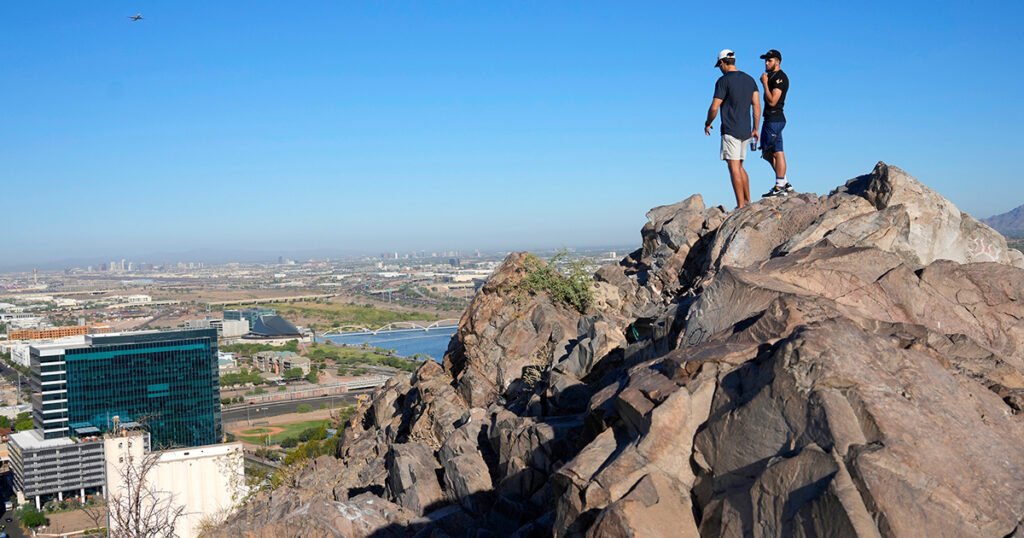Judy Schwiebert grew up in west Phoenix in the 1960s. Back then, the now booming city was what she describes as “a pretty small town,” and the biggest event of the year was a three-day rodeo.
Everything stopped for the rodeo parade, with horse-drawn carriages, marching bands, and dancers rolling through town. Schools were closed for three days, said Schwiebert, now a Democratic state representative. In 1969, the county’s population was less than 1 million and less than a quarter of its current area.
“Over the years, I’ve watched it continue to grow,” she said.
The area became a magnet for conservatives such as former New York Port Authority police officer John Kavanaugh. After 20 years in law enforcement, Kavanaugh and his wife headed west to Maricopa County.
Kavanaugh was like many people who moved to Arizona in the 1990s. They were middle-class people fleeing the cold and the economic and political dysfunction around them in search of what they perceived to be sunny, cheaper, and cleaner cities.
“A lot of people have come from other cities, and they don’t want a repeat of what they left,” Kavanaugh said.
The county’s population in 1993 was 2.3 million. Republicans controlled the state legislature and Maricopa County politics. Arizona was an early transplant state, and it was easier for new immigrants to enter politics than elsewhere. Mr. Kavanaugh was elected to the state House of Representatives in 2006 and is currently serving his first term as a state senator. Since his arrival, the county’s population has nearly doubled and its politics have changed.
Arizona currently has a Democratic governor elected in 2022. State Sens. Mark Kelly and Kyrsten Sinema were both elected as Democrats, but Sinema has since become an independent.
Kavanaugh said the county’s leftward shift is due to a wide range of factors, from social changes he believes are caused by the media and academia to people moving to Arizona for higher-paying jobs that require more education. I think it’s a thing.
“I hope there comes a point where people look at what the consequences are if this trend continues,” Kavanaugh said, predicting a strong November for Republicans. “Look at L.A., New York, Seattle. We’re going to continue to see a left shift there. So let’s make a hard stop and maybe take a few steps back to the right.”
It’s clear that many of the people who moved to Maricopa in the past few decades were not like Kavanaugh. The county’s conservative, low-tax approach attracted individuals as well as businesses, and those businesses attracted workers different from Arizona’s older immigrants.
Condos and apartments give way to the Phoenix skyline in Tempe, Arizona, Tuesday, Sept. 24, 2024. (AP Photo/Ross D. Franklin)

South Mountain Park and Preserve and Nearby Subdivisions, Phoenix, Thursday, June 27, 2024. (AP Photo/Serkan Gurbuz)

South Mountain Park and Preserve and Nearby Subdivisions, Phoenix, Thursday, June 27, 2024. (AP Photo/Serkan Gurbuz)
Kevin Henderson moved to Maricopa in 2010 at the age of 23 after living in Chicago and Portland, Oregon. A Democrat who works in catering, he was pleasantly surprised by life in the then-red state and its residents’ can-do attitude.
“People were very friendly,” said Henderson, now 37. “In such an eclectic group of people, we are fortunate to be very understanding and receptive to other people’s opinions.”
At the same time that people like Henderson came from other parts of the United States, increased immigration to Arizona from Mexico also prompted political changes.
In the 1990s, President Bill Clinton’s administration fortified California’s borders and encouraged illegal immigration into Arizona, which already had a large Hispanic population. Immigration quickly became a political flashpoint, with many of Maricopa’s growing legal Latino population feeling that the Republican Party was demonizing them.
The biggest change came in 2010, when Arizona’s Republican-controlled legislature passed a law allowing local police to stop people suspected of entering the country illegally. Although the U.S. Supreme Court overturned the law, it inspired Latinos in the state to organize against the Republican Party.
The law, which opponents dubbed “Show me your documents,” is the toughest anti-immigrant law in the nation and has changed Arizona politics, said Garcia, the Latino activist. It led to boycotts and protests. People at home and abroad knew about Republican Sheriff Joe Arpaio, who pushed for this law, and his anti-crime efforts targeting immigrants.
Republicans won the state by a landslide in 2010, and it seemed likely that the Republican Party would continue to fight for Maricopa County even as dissatisfaction among Latinos grew.
But things change when new Republican leadership comes in.







